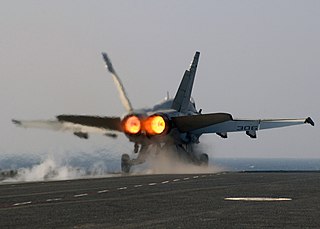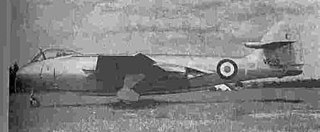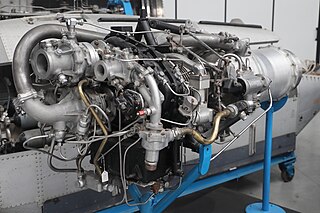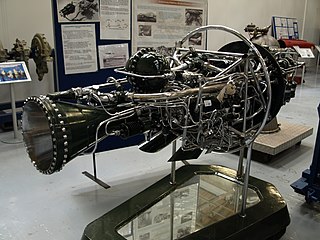Related Research Articles

The Republic XF-91 Thunderceptor is a mixed-propulsion prototype interceptor aircraft, developed by Republic Aviation. The aircraft would use a jet engine for most flight, and a cluster of four small rocket engines for added thrust during climb and interception. The design was largely obsolete by the time it was completed due to the rapidly increasing performance of contemporary jet engines, and only two prototypes were built. One of these was the first American fighter to exceed Mach 1 in level flight.

The Douglas D-558-2 Skyrocket is a rocket and jet-powered research supersonic aircraft built by the Douglas Aircraft Company for the United States Navy. On 20 November 1953, shortly before the 50th anniversary of powered flight, Scott Crossfield piloted the Skyrocket to Mach 2, or more than 1,290 mph (2076 km/h), the first time an aircraft had exceeded twice the speed of sound.

An afterburner is an additional combustion component used on some jet engines, mostly those on military supersonic aircraft. Its purpose is to increase thrust, usually for supersonic flight, takeoff, and combat. The afterburning process injects additional fuel into a combustor in the jet pipe behind the turbine, "reheating" the exhaust gas. Afterburning significantly increases thrust as an alternative to using a bigger engine with its attendant weight penalty, but at the cost of increased fuel consumption which limits its use to short periods. This aircraft application of "reheat" contrasts with the meaning and implementation of "reheat" applicable to gas turbines driving electrical generators and which reduces fuel consumption.
The XLR11, company designation RMI 6000C4, was the first liquid-propellant rocket engine developed in the United States for use in aircraft. It was designed and built by Reaction Motors Inc., and used ethyl alcohol and liquid oxygen as propellants to generate a maximum thrust of 6,000 lbf (27 kN). Each of the four combustion chambers produced 1,500 lbf (6.7 kN) of thrust. The engine was not throttleable but each chamber could be turned on and off individually.

The Saunders-Roe SR.53 was a British prototype interceptor aircraft of mixed jet and rocket propulsion developed for the Royal Air Force (RAF) by Saunders-Roe in the early 1950s. As envisaged, the SR.53 would have been used as an interceptor aircraft, using its rocket propulsion to rapidly climb and approach incoming hostile bombers at high speeds; following its attack run, the aircraft would then return to its base using jet propulsion.

The Reaction Motors LR99 engine was the first large, throttleable, restartable liquid-propellant rocket engine. Development began in the 1950s by the Reaction Motors Division of Thiokol Chemical Company to power the North American X-15 hypersonic research aircraft. It could deliver up to 57,000 lbf (250 kN) of thrust with a specific impulse of 279 s (2.74 km/s) or 239 s (2.34 km/s) at sea level. Thrust was variable from 50 to 100 percent, and the restart capability allowed it to be shut down and restarted during flight when necessary.

Bristol Siddeley Engines Ltd (BSEL) was a British aero engine manufacturer. The company was formed in 1959 by a merger of Bristol Aero-Engines Limited and Armstrong Siddeley Motors Limited. In 1961 the company was expanded by the purchase of the de Havilland Engine Company and the engine division of Blackburn Aircraft. Bristol Siddeley was purchased by Rolls-Royce Limited in 1966.

The Armstrong Siddeley Sapphire is a British turbojet engine that was produced by Armstrong Siddeley in the 1950s. It was the ultimate development of work that had started as the Metrovick F.2 in 1940, evolving into an advanced axial flow design with an annular combustion chamber that developed over 11,000 lbf (49 kN). It powered early versions of the Hawker Hunter and Handley Page Victor, and every Gloster Javelin. Production was also started under licence in the United States by Wright Aeronautical as the J65, powering a number of US designs. The Sapphire's primary competitor was the Rolls-Royce Avon.

The Hawker P.1052 was a British experimental aircraft built by Hawker Aircraft Limited for trials with swept wings.

The Hawker P.1072 was a 1949 experimental British aircraft acting as a test bed for the Armstrong Siddeley Snarler rocket booster engine. It was the prototype Hawker Sea Hawk modified to install the rocket in the tail.

The Armstrong Siddeley Viper is a British turbojet engine developed and produced by Armstrong Siddeley and then by its successor companies Bristol Siddeley and Rolls-Royce Limited. It entered service in 1953 and remained in use with the Royal Air Force, powering its Dominie T1 navigation training aircraft until January 2011.

The de Havilland Spectre is a rocket engine that was built by the de Havilland Engine Company in the 1950s. It was one element of the intended mixed power-plant for combination rocket-jet interceptor aircraft of the Royal Air Force, such as the Saunders-Roe SR.177.

The Armstrong Siddeley ASA.1 Adder was an early British turbojet engine developed by the Armstrong Siddeley company and first run in November 1948.

The Napier Scorpion series of rocket engines are a family of British liquid-fuelled engines that were developed and manufactured by Napier at the Napier Flight Development Establishment, Luton, in the late 1950s. The Scorpion range were designed and flight tested as boosters to improve aircraft take-off performance.

The Armstrong Siddeley Stentor, latterly Bristol Siddeley BSSt.1 Stentor, was a two-chamber HTP rocket engine used to power the Blue Steel stand-off missile carried by Britain's V bomber force. The high thrust chamber was used for the first 29 seconds, after which it was shut down and a smaller cruise chamber was used for the rest of the powered flight.

The Armstrong Siddeley Screamer was a British rocket engine intended to power the Avro 720 manned interceptor aircraft. Thrust was variable, up to a maximum of 8,000 lbf (36 kN).

The General Electric J73 turbojet was developed by General Electric from the earlier J47 engine. Its original USAF designation was J47-21, but with innovative features including variable inlet guide vanes, double-shell combustor case, and 50% greater airflow was redesignated J73. Its only operational use was in the North American F-86H.

The Avro 720 was an in-development British single-seat interceptor of the 1950s. It was designed and being developed by Avro in competition with the Saunders-Roe-built SR.53. While at least one prototype was partially-constructed, the order for the Avro 720, and quickly thereafter the project entirely, was terminated prior to any aircraft having been completed.

The SEPR 84 is a family of liquid-propellant rocket engines used as boosters for the Dassault Mirage III mixed-power high-altitude interceptor aircraft of the 1960s. The engine was one of several similar developed by SEPR.

The Société d'Études pour la Propulsion par Réaction (SEPR) was a French research and manufacturing company founded in 1944 which specialised in the development of liquid-fuelled rocket engines during the 1950s, 60s, 70s and 80s.
References
- ↑ S. Allen (7 December 1951). "Rockets for Aircraft Propulsion". The Aeroplane.
- ↑ "Snarler: Armstrong Siddeleys Oxygen Water-methanol Rocket Motor : Handling Liquid Oxygen". Flight : 92–93. 25 July 1952.
- 1 2 3 4 "Aero engines 1954". Flight : 447–448. 6 August 1954.
- 1 2 "Armstrong Siddeley Snarler". Flight : 92–93. 25 July 1952.
- ↑ "The Quest for Power..." Flight : 444. 6 August 1954.
Transferring liquid oxygen from a B.O.C. spherical tanker to the Hawker P.1072 in which the Sn rocket was tested. The gas is exhausting through the lower vents and rapidly evaporating.
- ↑ Although the Nene's thrust, as for any turbojet, fell with increasing altitude the Snarler's remained constant.
- ↑ "Armstrong Siddeley Screamer". Flight : 160–164. 27 July 1956.
- ↑ Wilkinson, Paul H. (1953). Aircraft engines of the World 1953 (11th ed.). London: Sir Isaac Pitman & Sons Ltd.
- ↑ "Armstrong Siddeley Snarler:THE DEVELOPMENT OF A PUMP-FED LIQUID-FUEL AIRCRAFT ROCKET". Flight. 66 (2376): 176–180. 6 August 1954. Retrieved 7 January 2019.